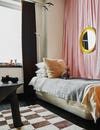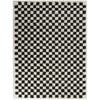Like a Good Fabric, Houseplants Add Texture in This Landscape Designer’s NYC Apartment
Everything is set against a backdrop of black lacquered floors.
Updated Jun 20, 2023 8:30 PM
We may earn revenue from the products available on this page and participate in affiliate programs.
“Predictability is achingly boring,” says Kimberly Von Koontz. “If something is left undone or lying against the wall, it gives the room a sense of impending evolution.” The California-raised landscape designer, who helped create the rooftop garden at 1 Hotel Brooklyn Bridge, abides by her word. Nothing in her spacious two-bedroom apartment—which she shares with her son, Romeo—is what you’d expect to find in the heart of Manhattan’s Financial District.
With her wavy butter-blonde hair and streamlined personal style, Von Koontz looks every bit the successful New York designer. But as with much of her life, the path was hardly predictable. As a junior studying architecture at the University of Colorado and visiting Florence, Italy, on a study-abroad program, she became so entranced with the culture she decided to leave school and stay. “It was massively influential,” she says of the time spent in the city. Later, she moved to Milan to earn a master’s degree in fashion brand management at the Istituto Marangoni and then to Hong Kong to handle marketing events for Lane Crawford, a luxury retailer.
A thrilling highlight was assisting Italian architect Roberto Baciocchi, who established the look of hundreds of Prada boutiques globally, with trend research for in-store displays. In 2012, when she arrived in New York—“The most sophisticated place I could dream up”—she quit the fashion world to devote herself to landscape design, which she had been studying in her spare time. Today her eponymous firm tackles everything from creating a meditative green roof for a renovated firehouse in Manhattan to studding a horse farm in upstate New York with scores of crab apple trees.
Like her landscapes, Von Koontz’s home has a sense of wildness to it that defies easy categorization. “I wasn’t trying to capture a mood,” she says nonchalantly of the living and dining areas. “This is literally a collection of my things.” The through-line here is the fact that every item is something she wants to own forever. Of course, with Italian mid-century collectibles, including a 1950s wood bar cart and Superleggera chair, it’s not hard to see why. A pair of low-slung Gae Aulenti chairs, placed around a glass table with a cantilevered steel base, play well with the “sexy” black lacquered floors, while an array of Italian sculptures, some by Giorgio de Chirico and Marino di Teana, hint at Von Koontz’s love of old-world refinement. The “menacing” aluminum blinds are a recent addition.
As one would hope, her home is a showcase for Von Koontz’s enviable green thumb. Rex begonias, with their splashy displays of color and love of indirect light, are perennial standbys, as is Strelizia nicolai, the white bird of paradise with a hauntingly beautiful flower. (Romeo’s pick: the escargot, whose snail-like foliage makes him gasp, “Oh, wow, Mama!”) Much like the hallway, which dazzles with an enormous abstract tapestry by French painter Edgard Pillet and a pair of Carl Fagerlund mirrors scored from Von Koontz’s friends at Maison Gerard in Greenwich Village, Romeo’s bedroom is a study in contrasts. A banner of slick bubblegum pink fabric Baciocchi made for Prada hangs from the wall by the bed, a cheeky rebuff to the vignette of neutrals—a chocolate-and-cream checkerboard rug, an industrial table, and a resin and papier-mâché chair. “It has this speed to it,” Von Koontz says fondly of the cloth. “And that little yellow mirror worked out perfectly, too.”
Still, she doesn’t like her apartment to feel too crowded, so she stores many things, including treasured ones, in a warehouse. Culling and editing Romeo’s toys has become a pastime, and she isn’t afraid to give things away. “I think having 10 inspiring toys is far more useful for a young mind than thousands,” she notes. Coming from someone who has owned the same plates for 25 years, this makes sense. “Never buy anything that you don’t totally love,” Von Koontz states adamantly. “Go without the dishes until you can get the ones you want.” This strict sensibility informs how she lives. She likes a set table—preferably with 18th-century Chinese plates, silverware inlaid with Swarovski crystal, and prized Venetian glasses plucked at a street market. “All these temporary baby things go against my creed of purchasing something you’ll keep forever,” she says. Not that Romeo isn’t making his mark. He has his own idea of keepsake possessions, and if you look closely, you’ll see toy animals lining his windowsill. Says Von Koontz, “The house has never been given over to kids, but I’m increasingly seeing how he’s spreading his wings.”
The Goods
This story was originally published in our Spring 2019 issue with the headline “In Pursuit of Beauty.”















